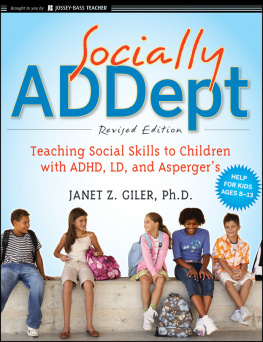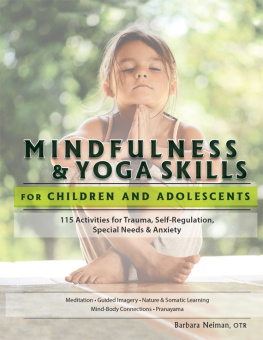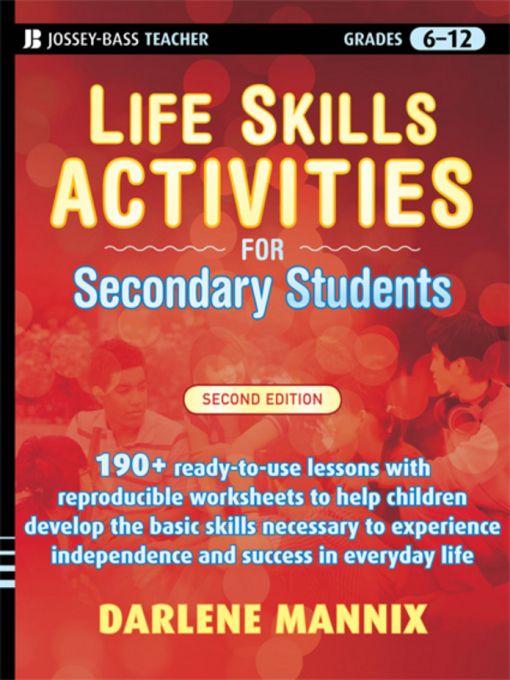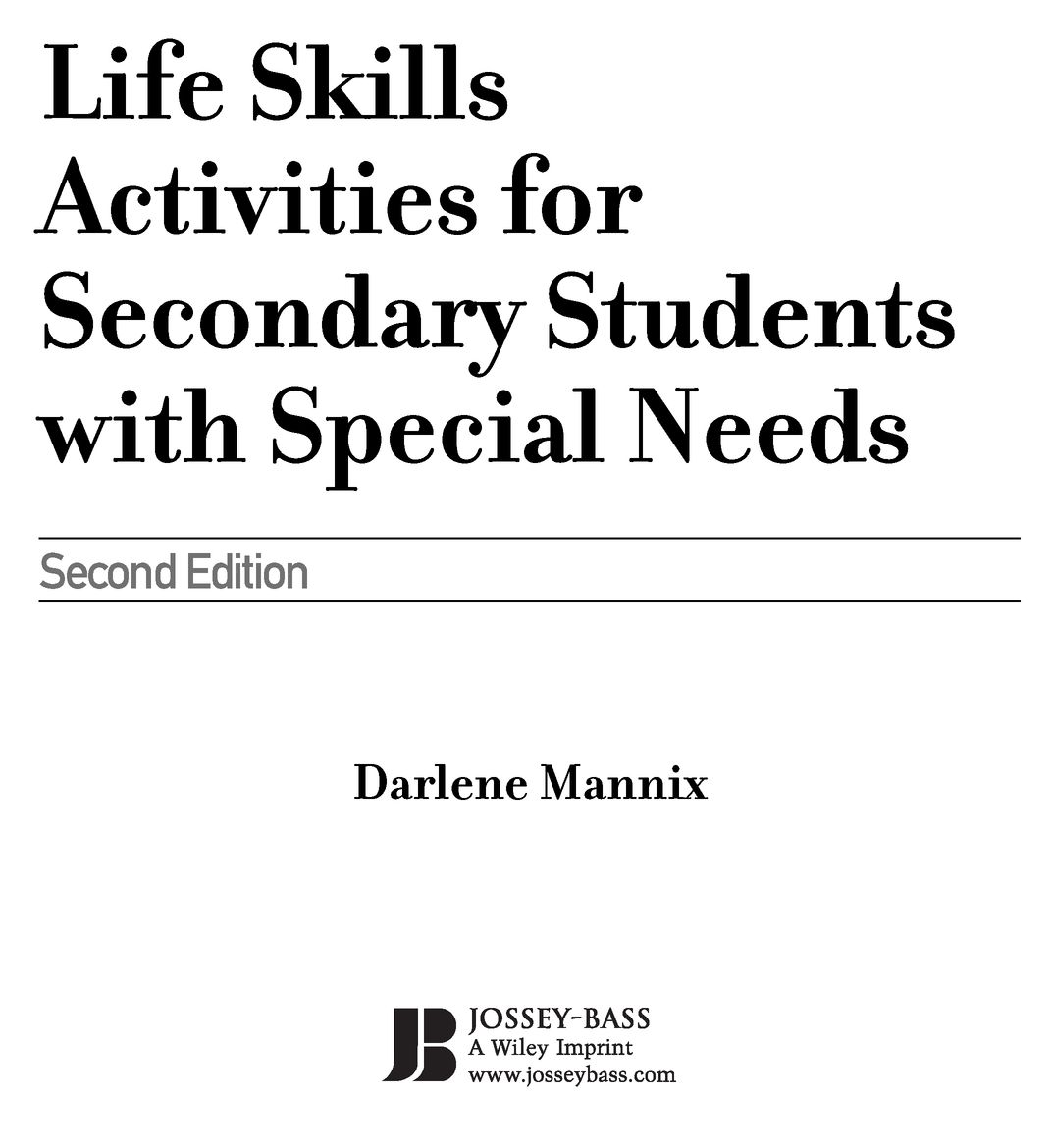Table of Contents
Jossey-Bass Teacher
Jossey-Bass Teacher provides educators with practical knowledge and tools to create a positive and lifelong impact on student learning. We offer classroom-tested and research-based teaching resources for a variety of grade levels and subject areas. Whether you are an aspiring, new, or veteran teacher, we want to help you make every teaching day your best.
From ready-to-use classroom activities to the latest teaching framework, our value-packed books provide insightful, practical, and comprehensive materials on the topics that matter most to K-12 teachers. We hope to become your trusted source for the best ideas from the most experienced and respected experts in the field.
About This Book
Life Skills Activities for Secondary Students with Special Needs is a resource for special education and regular education teachers, counselors, parents, paraprofessionals, and others who are involved in the education, training, employment, or socialization of students.
What Are Life Skills?
Basically, life skills are a group of skills that an individual needs to acquire for an independent life, as far as that life is possible. One could argue that the most important skills one acquires in life are the skills of sound character, such as honesty, kindness, and being responsible. At school, students need to acquire the whole realm of academic skills, including reading, writing, and solving math problems. In addition, school is a microcosm of society that demands the acquisition of appropriate social skills. Life skills also includes the many tasks that make up daily living, such as shopping, saving money, traveling, or eating. Vocational skills are another component of what a special needs child will need to acquirefinding and maintaining an appropriate job. Problem-solving skills are a vital thinking technique that can be superimposed on all of the other areas.
Why Teach Life Skills?
The teaching of life skills is an ongoing process for children. It can take place in many campuses (at school, at home, in the community) and be taught by many teachers (including professional educators, the bus driver, your neighbor, other children, and community leaders). Sometimes, however, it is best to have a directed goal with a target in mind to help stay focused on what your child needs to learn. Having a specific goal helps not only the student, but the teacher or parent as well.
What Students Will Use This Book?
The lessons in this book are primarily directed toward middle school or younger high school students who have a special need for learning. This special need might be a social disability, learning disability, or moderate mental or physical handicap that requires slowing down the pace of the task, going step -by-step toward a goal, needing extra practice, learning through targeted discussion, and/or simply steering them toward the core skill.
The material can be adapted for a variety of uses. Answers can be oral or written, students can work individually or in groups, activities can be tailored to fit whatever needs are more pressing.
How Do I Use This Book?
As a teacher or parent, you have many options as far as using the material in this book. A typical lesson contains these elements:
A specific objective for the lesson
Brief comments about the nature or importance of the skill
An introductory activity or two
Discussion questions pertaining to the skill
Answer key or suggested responses
An extension activity or two
Evaluation items
In addition, there are parent activities and suggestions for each of the six sections.
The book is organized into six main parts:
Part One, Self-Awareness, contains twenty-one lessons on character (being responsible, loyal, kind, and so on), individual uniqueness (ethnicity, disabilities, reputation, and so on), and personal life choices (such as smoking, drinking, tattoos, moving out).
Part Two, People Skills, contains forty-one lessons on relating to others (such as working with others, being in a good mood), developing friendship skills (recognizing people who are the same as or different from you, social networking, and so on), and being part of a family (such as understanding anothers point of view, sharing space), and communicating (being a good listener, understanding verbal and nonverbal messages, and so on).
Part Three, Academic and School Skills, is primarily related to education and contains thirty lessons on reading, writing, math, and study skills. Teachers in a school setting may find this section helpful for their students.
Part Four, Practical Living Skills, is a longer section containing fifty-four lessons on acquiring information, handling money, travel, clothing, living arrangements, eating and nutrition, shopping, and including exercise and hygiene in your life. Parents of special needs teens may use this section in a home environment.
Part Five, Vocational Skills, contains twenty-two lessons on understanding present skills and interests (hobbies and strengths), getting a job (filling out an application, interviewing, and so on), and actual working (skills needed to be a good employee).
Part Six, Problem-Solving Skills, has twenty-three lessons on skills such as handling problem situations, making decisions, using good resource management, goal-setting, and risk-taking. The examples in these lessons come from home, school, work, and community settings.
Life Skills Activities for Secondary Students with Special Needs was first published in 1995. To reflect changes in education and current social needs, many lessons have been added or updated.
Part One, Self-Awareness, includes a chapter on My Character, which brings into focus character-building skills such as kindness, honesty, and responsibility. These skills are timeless in their value in any program for any student. Other lessons address tattoos and piercings, having a disability, and making life choices about moving out or getting a part-time job.
Part Two, People Skills, includes updated material about social relationships, including noticing the moods of others and how ones mood affects others, places to find friends, social networking online, understanding anothers point of view, and using a cell phone.
Part Three, Academic and School Skills, has lessons on e-mailing, using computers to improve school tasks, and using computers to find information online.
Part Four, Practical Living Skills, now includes obtaining information from the Internet; taking classes for further learning; using debit, credit, and ATM cards; overnight travel; care of clothing; going green smart shopping; learning about nutrition; and the importance of daily exercise.
Part Five, Vocational Skills, includes revisions to the sections on interviewing for a job, searching for a job, creating a good first impression, and how to handle making mistakes and criticism on the job.
Part Six, Problem-Solving Skills, has lessons about seeing oneself as the problem, taking risks, and handling fearful situations.
There are a total of 191 lessons, 62 of which are new, for a total of 32 percent revised material. There are numerous minor updates and revisions on many of the retained lessons as well.






